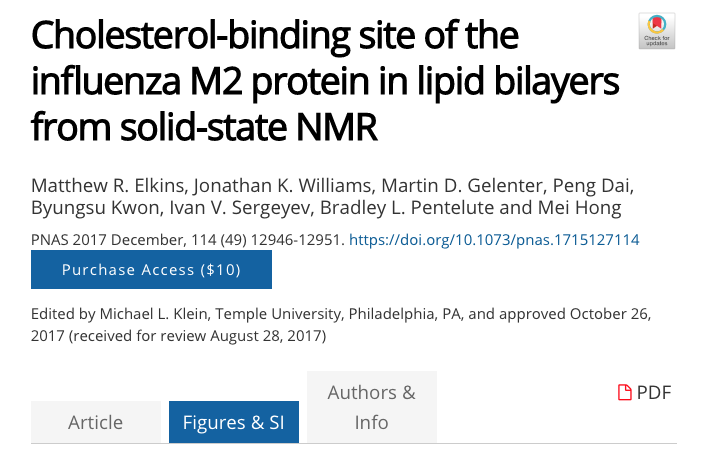Cholesterol-binding site of the influenza M2 protein in lipid bilayers from solid-state NMR
The influenza M2 protein not only forms a proton channel but also mediates membrane scission in a cholesterol-dependent manner to cause virus budding and release. The atomic interaction of cholesterol with M2, as with most eukaryotic membrane proteins, has long been elusive. We have now determined the cholesterol-binding site of the M2 protein in phospholipid bilayers using solid-state NMR spectroscopy. Chain-fluorinated cholesterol was used to measure cholesterol proximity to M2 while sterol-deuterated cholesterol was used to measure bound-cholesterol orientation in lipid bilayers. Carbon–fluorine distance measurements show that at a cholesterol concentration of 17 mol%, two cholesterol molecules bind each M2 tetramer. Cholesterol binds the C-terminal transmembrane (TM) residues, near an amphipathic helix, without requiring a cholesterol recognition sequence motif. Deuterium NMR spectra indicate that bound cholesterol is approximately parallel to the bilayer normal, with the rough face of the sterol rings apposed to methyl-rich TM residues. The distance- and orientation-restrained cholesterol-binding site structure shows that cholesterol is stabilized by hydrophobic interactions with the TM helix and polar and aromatic interactions with neighboring amphipathic helices. At the 1:2 binding stoichiometry, lipid 31P spectra show an isotropic peak indicative of high membrane curvature. This M2–cholesterol complex structure, together with previously observed M2 localization at phase boundaries, suggests that cholesterol mediates M2 clustering to the neck of the budding virus to cause the necessary curvature for membrane scission. The solid-state NMR approach developed here is generally applicable for elucidating the structural basis of cholesterol’s effects on membrane protein function.
Pentelute Lab, MIT, Cambridge, Chemistry, Molecular biology, technology development, peptide, protein-based therapeutics, chemical Biology
17075
wp-singular,portfolio_page-template-default,single,single-portfolio_page,postid-17075,wp-theme-bridge,bridge-core-3.0.1,qode-page-transition-enabled,ajax_fade,page_not_loaded,,paspartu_enabled,paspartu_on_top_fixed,paspartu_on_bottom_fixed,qode_grid_1200,qode_popup_menu_push_text_top,qode-theme-ver-28.7,qode-theme-bridge,disabled_footer_top,wpb-js-composer js-comp-ver-6.8.0,vc_responsive
Cholesterol-binding site of the influenza M2 protein in lipid bilayers from solid-state NMR
Cholesterol-binding site of the influenza M2 protein in lipid bilayers from solid-state NMR
PNAS 2017
December, 114 (49) 12946-12951
doi.org/10.1073/pnas.1715127114
Matthew R. Elkins, Jonathan K. Williams, Martin D. Gelenter, Peng Dai, Byungsu Kwon, Ivan V. Sergeyev, Bradley L. Pentelute and Mei Hong
Abstract
The influenza M2 protein not only forms a proton channel but also mediates membrane scission in a cholesterol-dependent manner to cause virus budding and release. The atomic interaction of cholesterol with M2, as with most eukaryotic membrane proteins, has long been elusive. We have now determined the cholesterol-binding site of the M2 protein in phospholipid bilayers using solid-state NMR spectroscopy. Chain-fluorinated cholesterol was used to measure cholesterol proximity to M2 while sterol-deuterated cholesterol was used to measure bound-cholesterol orientation in lipid bilayers. Carbon–fluorine distance measurements show that at a cholesterol concentration of 17 mol%, two cholesterol molecules bind each M2 tetramer. Cholesterol binds the C-terminal transmembrane (TM) residues, near an amphipathic helix, without requiring a cholesterol recognition sequence motif. Deuterium NMR spectra indicate that bound cholesterol is approximately parallel to the bilayer normal, with the rough face of the sterol rings apposed to methyl-rich TM residues. The distance- and orientation-restrained cholesterol-binding site structure shows that cholesterol is stabilized by hydrophobic interactions with the TM helix and polar and aromatic interactions with neighboring amphipathic helices. At the 1:2 binding stoichiometry, lipid 31P spectra show an isotropic peak indicative of high membrane curvature. This M2–cholesterol complex structure, together with previously observed M2 localization at phase boundaries, suggests that cholesterol mediates M2 clustering to the neck of the budding virus to cause the necessary curvature for membrane scission. The solid-state NMR approach developed here is generally applicable for elucidating the structural basis of cholesterol’s effects on membrane protein function.
Category
2017, Publications





